TUESDAY AT CES
CES for Photographers
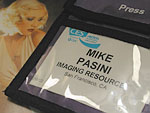
By MIKE PASINI
Editor
The Imaging Resource Digital Photography Newsletter
LAS VEGAS, Nev. -- The Consumer Electronics Show doesn't focus on digital imaging. Among its 2,700 exhibits covering 1.8 million square feet of exhibit space, imaging firms are spread far and wide, making it impossible to visit many of them in one day.
|
|
But in trekking from Canon to Nikon to Olympus to Pentax and other camera vendors, we ran across some intriguing products for photographers nonetheless. Here are the highlights.
Celestron (http://www.celestron.com) is famous for its telescopes. So how tough could it be for them to pop a spotting scope on a digicam? The $479 Vistapix IS70 answers that question with its two-inch LCD and 14x-magnification (objects are enlarged 14 times), fully-coated lens featuring a 70mm aperture and 210mm focal length attached to a 3.1-megapixel digicam with an SD card slot.

Vistapix IS70. Scope plus 3.1-Mp digicam.
Spotting scopes are ideal for terrestrial viewing, providing high magnification with a wide enough angle of view to see something through the distortion of heat waves. They range somewhere between the 10x magnification of a long zoom and a 60x entry-level telescope. The Vistapix is unusual for a scope in that it includes, like a telescope, a small auxiliary wide angle lens to help aim the device in the right direction. It can be hard to find your subject at high magnification.
To test the handsome unit, we popped our SD card into the model on display in the booth and captured some intriguing stills and video. It took four guys in the booth to actually figure out how to record the images to the card (there's nothing to it, just pop the card in), but the scope did it.
Actually, in their defense, the problem wasn't the scope, but the Kodak digicam we were reviewing the images on. We couldn't see the video capture on the Kodak playback index. It turns out, we learned later, that a Kodak digicam doesn't support video taken on any camera other than itself. But the file was there.
There's a big switch on top that switches from the actual scope to a very small, wider angle lens just next to the scope. The smaller lens lets you view the whole field before zooming to the area you're interested in with the scope.
The flip-up LCD has a focus gauge that shows you just how well the scope has focused on its target. As you manually tweak focus, the magenta bar climbs up the screen. When you're ready to shoot, you just press the shutter button. If there's an SD card in the camera, the image is saved from the CMOS sensor to the card. Otherwise, it's saved in the camera's 32-MB of internal memory.
The Vistapix is a very attractive, well-built unit. You can use it as a scope through the eyepiece and capture images with the camera as well. But you can also plug it into your television via the AV port or your computer via the USB port.
EXPRESSCARD | Back to Contents
If you rely on a laptop to process your images, you've probably got a collection of PCMCIA adapters for your various flash memory cards so you can just pop them into the PCMCIA slot of your laptop.
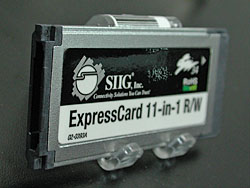
ExpressCard Reader. But not for CompactFlash.
But if you've bought a laptop recently, you may be chagrined to find no PCMCIA slot. Don't despair and run out to get a USB card reader. There's a much better alternative.
The old PCMCIA slot with an eject button has been replaced by a new standard, the ExpressCard (http://www.expresscard.org/web/site/qa.jsp). No eject button (saving laptop manufacturers a few bucks) and higher transfer speed are the two compelling reasons to upgrade your adapter collection.
The joy of doing away with the eject button speaks for itself. But the speed bump needs a little explanation. PCMCIA delivers a little over 1000 MB/sec, a bit over twice as fast as FireWire 400 and USB 2.0. Which is why you preferred PCMCIA over card readers in the first place. But at 2000-MB/sec ExpressCard doubles what PCMCIA can do. Which is why you'll want to update your adapter collection to include ExpressCards.
Unfortunately, cards to read flash memory have been slow (and expensive) coming to market. But at CES, we found some. The 11-in-1 reader from SIIG (http://www.siig.com) is typical of the new breed, able to read SD, miniSD, MMC, RS-MMC, xD Picture Card and some types of Memory Stick.
What it can't read is CompactFlash, which is wider than the narrower ExpressCard form factor of 34mm. But some companies have managed to work around that limitation with adapters for CompactFlash cards that have a narrow bus connector and a wide card connector.
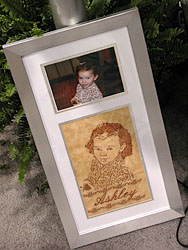
Digicam Embroidery. Single needle in about 15 minutes.
BROTHER EMBROIDERY | Back to Contents
Computers and sewing machines have been dating for years. But Brother's embroidery system (http://www.brother.com) can reproduce your digicam images as embroidery.
The basic components of the system are 1) a Windows computer running Brother's $99 PE-Design software and 2) a USB Brother sewing machine (either the $1,800 Innov-is 1200 or $6,000 Innov-is 4000D, both of which are single needle machines; the six needle PR-600 II costs $9,999.95 but gets the job done more quickly)
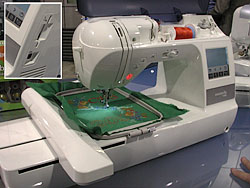
USB Sewing. Inset shows location of USB port for thumb drive on the Innov-is 1200.
At about 9,000 stitches a minute (if we heard right), you can embroider a monotone line drawing from a digicam image in about 15 minutes on even a single needle machine. The samples we saw at the Brother booth were impressive.
And the process is relatively simple (compared to printing an archival print with the right ICC profile, anyway). Once the software has digitized your image into an embroidery pattern, you copy it to a USB thumb drive. The drive plugs in to your Brother sewing machine, which reads the image and tells you on its touch-screen LCD step-by-step what to do on the machine to embroider the image on the fabric of your choice. The fabric is held taut on a 12x7 frame and the machine does all the work except changing thread color.
On the single needle machines, you have to rethread the needle every time the color changes (which is not a big deal on monochrome embroidery). The six-needle machine can run pretty much unattended, however, which accounts for its much higher price.
Canon (http://www.canon.com) was showing off those gorgeous dye-based prints from its Pro9000, which we recently reviewed (http://www.imaging-resource.com/PRINT/CP9K/CP9KA.HTM). But what caught our eye was its latest SELPHY dye sublimation 4x6 printer, the SELPHY ES1.
Canon has stood this little SELPHY on end. The $250 ES1 has a handle on top (that neatly hides behind it when you set it down), a retractable USB cord (so you always have it with you) and an optional battery so you can really print anywhere with this unit. It also has a card reader.
The unit has been designed to hold the combined ribbon/paper cartridge inside the printer (there's no paper cassette sticking out of the printer) without increasing the ES1's thickness. That makes for an interesting little dance at the beginning of each print job (which still takes only 60 seconds a print). The paper has to be fed from the cassette sideways, turned around and aligned to feed properly. We caught it on video for you through the yellow dye print stage.
Canon has also developed an intriguing new section of its Web site, which it calls Creative Park (http://www.canon.com/c-park). The site hosts a number of printing projects, many of them educational, that can be downloaded and printed on your own printer (a Canon, right?). Project categories include Greeting Cards, Scrapbooking, 3D Paper Craft, Calendars and more.
You read through our reviews and finally make the agonizing choice for a new camera only to find you aren't comfortable with the included shoulder strap. Maybe you want a wrist strap. Or maybe you just want to be able to quickly switch between a wide shoulder strap and a thin one and maybe occasionally even a wrist strap.
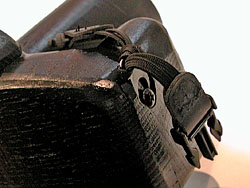
Op/Tech Quick Release. This is what stays on the camera and grabs any strap you attach.
How are you going to do that quickly?
Op/Tech (http://www.optechusa.com) has a quick release system. Simply tie a plastic latch to your camera's strap holders and pop any strap (wrist or shoulder) to the latches. And there are quite a few options when it comes to straps.
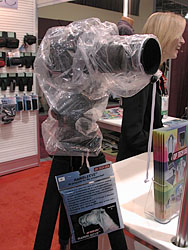
Rainsleeve. Simple solution and you get two in the package.
Among the more intriguing features is the company's non-slip grip, a series of soft, rounded bumps that grab hold of any fabric. The neoprene straps has what Op/Tech has patented as a "control-stretch" backing that contours to the shoulder and neck, distributing weight over a larger area than usual. It also functions as a shock absorber, making heavy loads feel much lighter.
The company also introduced its new Rainsleeve weather protection for your camera. Each packages actually contains two Rainsleeves, which are large, clear plastic bags with a draw string to close one end around the lens (leaving it open). There's also a small opening for the eyepiece and another for your hand or a tripod. The cover itself isn't tailored to any specific device, but large enough to fit any camera and lens up to seven inches in diameter and 18 inches long.
HYPERDRIVE SPACE | Back to Contents
One small booth drew quite a crowd. The Hyperdrive Space (http://www.hyperdrive.com) was the attraction, a portable storage device that copies data from 18 types of memory card.
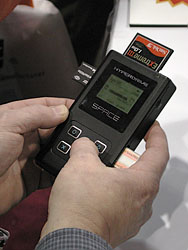
The Space. Pretty smart box for storing images in the field.
Hypercard claims the aluminum Space is the world's fastest at 20MB/s, downloading 1-GB in less than a minute and 28-Mb/s USB transfers, with the longest battery performance, offering 100-GB of downloading on full charge of its laptop-equivalent lith-ion battery or 300-GB with an external pack (thanks to the black and white LCD, no doubt). It also features a 32-bit verification system with error correction coding (something your simple file copy doesn't do) and built-in clock for copy timestamping.
It's got some brains, too. It shuts itself down, parking the hard disk heads, when inactive and can auto copy, format the drive and erase the inserted memory card. It can detect when an image has already been copied so you don't have duplicates on the drive. And it reminds you what the last backup was when you start it up. You can also do firmware upgrades from the hard drive.
Backups can be done at five speeds (hyper, ultra, high and normal) and the five button keyboard provides access to any feature in no more than five taps.
It's fairly compact at just 5 x 2.87 x 0.79 inches. The 1.8 inch monochrome screen is illuminated with a backlight, too. And there's a built-in power surge protector.
You can buy the space without a drive for $149. A 60-GB version costs $239 and the largest option, with a 160-GB drive, runs $359.
We're not big fans of devices like these because they merely shift the risk of carrying a single copy of your images from your card to the device. There's no redundancy, no second copy, once you erase your card. So they're little more than storage devices with the convenience of a card reader. If you don't need to review images on your storage device, though, the Space makes storing your images a breeze.
When we last saw the $35 Popabrella (http://www.popabrella.com), it was a charming solution for protecting your camera from rain and, more importantly, sun (shading the lens no matter which direction you aim the camera). But the company has added a compelling twist to the plot with a new silver interior lining designed for flash bounce.
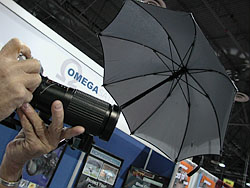
Popabrella. Now with a bounce flash interior.
Since you attach the Popabrella to your camera using the tripod socket, the ideal flash solution would be a strobe you can mount on the camera's hot shoe with a flash head that rotates to face backward and fire into the Popabrella, which can be aligned in almost any direction. The company is considering a gold lining as well, but at the moment, silver is the only option.
Adding the bounce flash lining to this sun shade solution makes the Popabrella a great idea for both indoor and outdoor photographers.
As interesting as we found these products, the most fascinating hour of the day was spent at a conference where some heavy hitters discussed the future of digital photography. We'll have a synopsis of that discussion in our next piece.